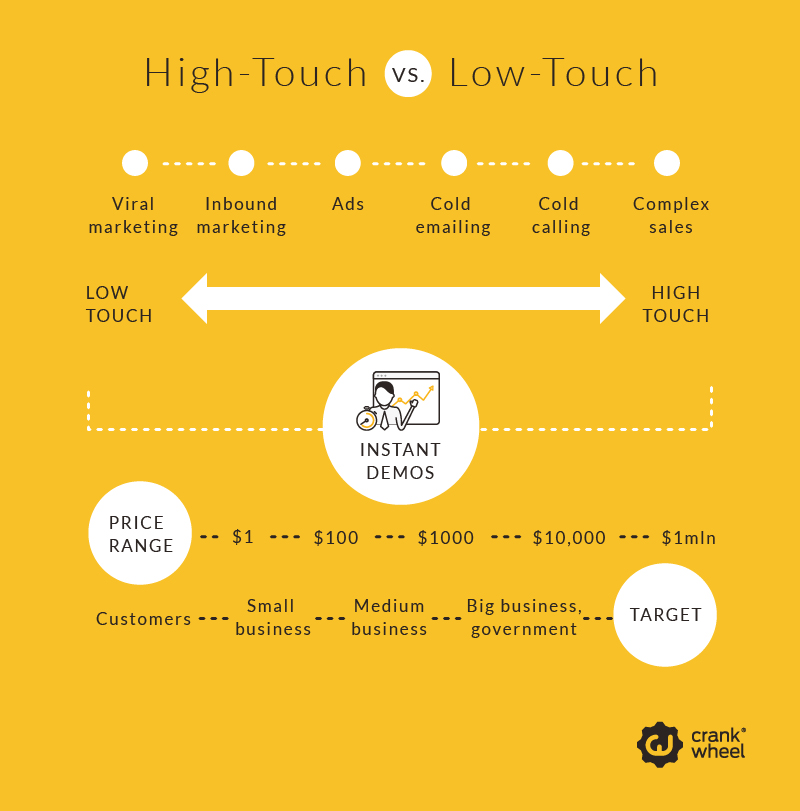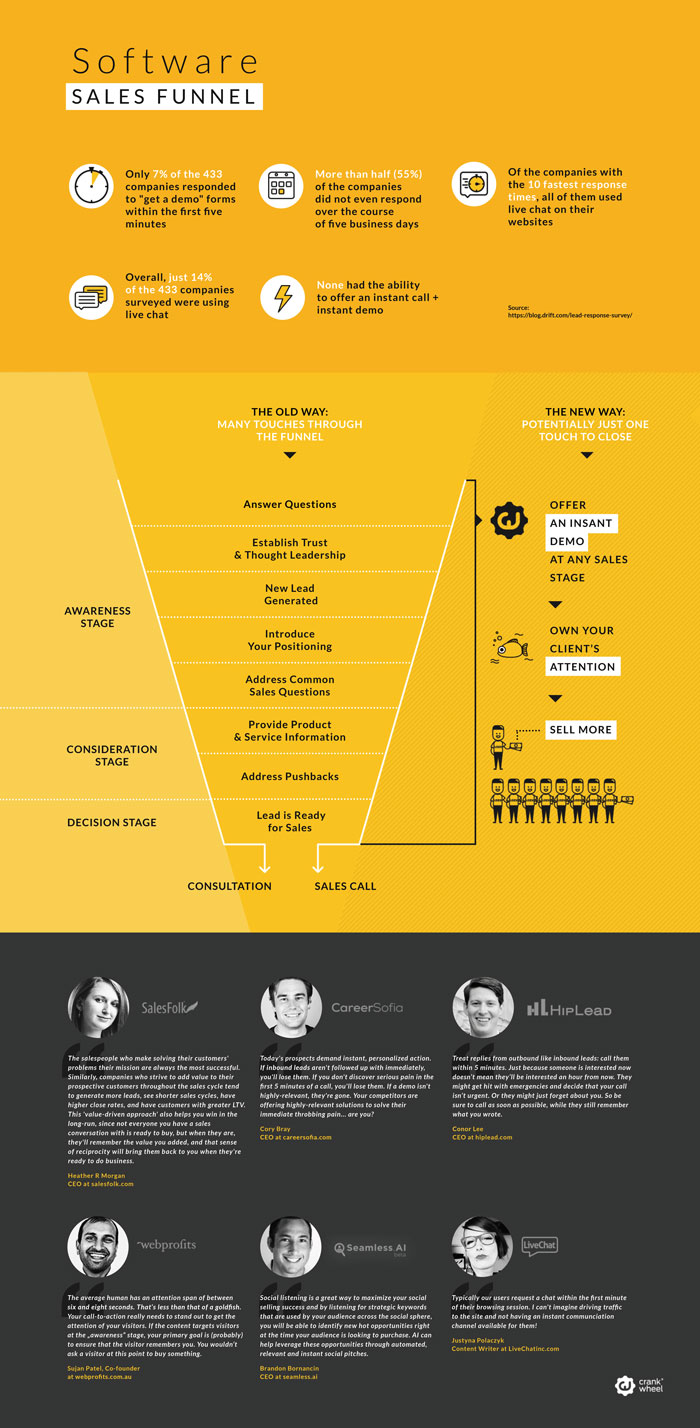How to generate more revenue: High-Touch vs. Low-Touch sales
David Skok, a serial entrepreneur turned VC, with Matrix Partners, coined the phrase, “touchless conversion sales model” around seven years ago, with an article that neatly summed up the low-touch sales model.
Something software founders and entrepreneurs should aim toward, since the lower their customer acquisition costs, the more they will make over the lifetime of each customer.

Shortcuts:
- What is a High-Touch Sales Model?
- What is a Low-Touch Sales Model?
- What Does a Low-Touch Model Need?
What is a High-Touch Sales Model?
A high-touch sales funnel refers to a funnel that is set up with careful interactions with other humans at each touchpoint. It can often be used for more complex products and services or more luxurious products.
The difference between high touch and low touch for the end customer can be between calling a stockbroker to execute orders versus executing trades in an app.
Another way to look at it is the difference between booking a flight and hotel for a weekend getaway through a travel aggregator versus going to a travel agency to buy a package for a month-long trip to another part of the world.
What is a Low-Touch Sales Model?
A low-touch sales funnel is designed so the customer needs little or no interaction with a human being during the process.
In order to make the customer’s flow through the funnel to be mostly self-service, every touchpoint has to be thought out and designed to be as easy as possible for the customer to get through without assistance.
Even though there is no human interaction, it does not mean that there goes less work into designing a Low-touch customer journey. The model has to be designed with human behavior in mind and you will have to measure each touchpoint and implement changes or new nudges to make the experience as smooth as possible.
What Does a Low-Touch Model Need?
The perfect low-touch model is when you walk into a shop, buy what you want, through an automated checkout and leave.
Amazon is a prime example of the low-touch model. In comparison, making a higher-value purchase, such as a car, a house, or an expensive piece of software, involves multiple interactions between people. Consequently, these extra costs are factored into the price.
For Enterprise software companies, the high-touch model is factored into the cost of doing business. Field sales agents, account managers and post-sale engineers are often needed when selling into large corporate accounts.
These deals take time and involve multiple stakeholders. On the other hand, when you are selling to small and medium companies, the sales cycle is shorter, and therefore, it’s easier to implement a low-touch model to acquire leads and convert customers.
There is less need for much customer service to help customers to figure out the ins and outs of your offering.
Let’s take a look at the components of an effective low-touch model for SaaS and tech companies.

1: A source of leads
Most startups work with a combination of internal (founders, plus staff) and external resources (agencies and freelancers). They invest in a mix of organic and paid campaigns across a range of channels and platforms, usually no more than ten.
As startups grow, the immediate hustle of the early days is replaced by a more structured, metric-driven approach.
Buying or scraping data is dropped for more effective, opt-in permission marketing approaches. That means ramping up content, email and social media marketing.
Every decision you make when designing a marketing campaign needs to centre around getting noticed by potential buyers. Know your decision-makers, budget holders and end-users.
Create content that appeals to them, educates them and makes them want to share with stakeholders in their organisation.
This means placing the content carefully across the Internet. Focus on channels where these potential buyers and stakeholders spend time online. This can be forums to sector-specific media, blogs and social networks. Add value at every stage.

2: Sales Leads Pipeline
Now that you have a scalable source of leads you need to qualify them as a sales prospect. Do they fit your customer profile? Do they need your software, and if so, can they pay?
Qualifying a lead is one of the most challenging aspects of scaling a sales pipeline. Leads are more than names and contact details in CRMs and Excel documents.
We should only classify leads as active when they are a decision maker, budget holder or end-user. They will either use or pay for the product you are selling.
The sooner you can confirm this, the quicker you can input these prospects into your sales pipeline.
One of the most effective ways is to arrange an Instant Demo. Most potential prospects rarely respond after one email.
Ideally, you should filter your prospects into an automated sales email campaign, while sending them content they will find useful.
Stay on their radar, without annoying them. An entire inbound marketing industry, including companies like HubSpot, are built on this concept.
Time and persistence are key. Companies that respond quicker have a much higher chance of converting a potential customer.
Keep in contact after a demo, and if you haven’t yet talked with a budget holder or decision maker, encourage your point of contact (normally an end-user) to share content with them, or arrange another instant demo.
3: Self-service for new users
We believe that every potential buyer should be able to implement software solutions before becoming contract-bound. The problem with this approach however is that it enforces fully-featured trial periods.
While these are great for some types of products, they can drastically increase the cost per acquisition, in turn inflating final costs.
This is especially true for software that needs to utilize 3rd party channels that have a significant cost, such as phone conferencing. Not to mention trial abandonment rates and the work salespeople need to do to maintain such a leaky funnel!
Locking away access to the bolts and joints of a particular product behind a paywall can result in an empty pipeline. It’s not an ideal alternative to trials, still, it allows you to focus on organizational leads who actually want to try your software.
Ourselves, we’re experimenting with a 30-day money-back guarantee which allows thorough, unsupervised tests, but with a fallback mechanism. There’s also a limited Free plan for users who don’t quite fit our ideal customer profile but still need our software.
Unfortunately figuring out what’s best for self-service, whether it’s a trial or freemium model depends very much on the specifics of your product or service and is therefore totally up to you.
Experiment with pricing, make assumptions and implement models that work for your business.
Further reading:
See our Guide to telesales for the resources you need to drive even more revenue.
